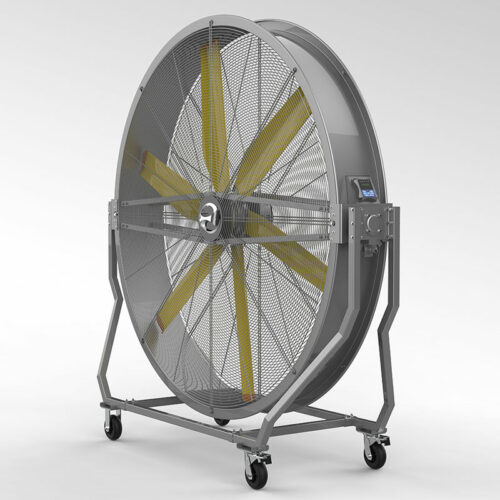The combination of industrial large HVLS ceiling fans and factory workshops, low-carbon emission reduction, environmental protection, and energy saving, realizes the “green organic” of the environment. It has created a good story in different scenarios and various airflow problems. Among them, there are also some factories that have been afraid to install cooling equipment due to the fear of potential safety hazards in the factory buildings. In order to alleviate the concerns of all customers, today we will introduce to you how the Diamond HVLS ceiling fan helps to ventilate and cool down the workshop with a traveling crane.
The traveling cranes used in the factory are basically the same as the cranes we usually call, such as cranes, aerial vehicles, and overhead cranes. They are used to hoist and transport goods. Among them, ordinary overhead cranes with large lifting capacities that are easy to install and adjust are used by most factories. However, the traveling crane will not be installed directly on the top of the factory, and a distance of 2-1.5 meters will be left between the traveling crane and the roof, which occupies most of the space on the top and makes it difficult to install cooling equipment in the factory. But now, installing large industrial HVLS ceiling fans is no longer a problem.
Diamond industrial large HVLS ceiling fan is equipped with PMSM permanent magnet synchronous motor, which is small in size, and the fan blade and motor rotation are integrated, saving space. And the traditional HVLS ceiling fan adopts a large-size reducer, and it is a safety hazard if it is forcibly installed in the distance between the top and the traveling crane. In addition, the drop tubes of the Diamond industrial HVLS ceiling fans can be selected in different lengths to ensure that the fan is installed at the most suitable and safe distance from the driving crane. After installation, there will be a safe distance of at least 20-30 cm between the bottom of the fan blade and the driving crane. At the same time, it does not affect the HVLS fan to help the factory ventilate and cool down.
Diamond Fan also has an experienced team of architectural, mechanical, and electrical engineers. According to different space structures, we can reasonably plan solutions for our customers. Engineers consider and plan different plant structures from a global perspective so that industrial energy-saving HVLS ceiling fans can exert better potential. And provide customers with corresponding installation services, strictly comply with operating specifications and installation standards, experienced installation personnel, ensure well-equipped operation, standardized torque tightening, installation site dynamic balance test, comprehensive test, and issue a test report.
The machining industry is also a heavy industry to a certain extent. For heavy industry, the most troublesome production in summer and autumn is the ventilation and cooling of the workshop. There is a lot of physical work in machining, for example, handling materials, high temperatures in summer and autumn, and long-term physical work can easily cause emotional fluctuations in the staff, which is not a good thing for production. The application of industrial large HVLS ceiling fans is really a weapon for cooling and ventilation in summer and autumn for the machining industry.
The ventilation and cooling methods generally used in the current mechanical processing industry in summer and autumn are still relatively traditional. Basically, two methods can be summarized: The first method is to prepare drinks for the workshop staff, such as boiled mung bean porridge. The ventilation and cooling methods commonly used in the current mechanical processing industry in summer and autumn are still relatively traditional. Basically, two methods can be summarized: The first method is to prepare drinks for the workshop staff. Of course, this is only an auxiliary function, after all, it is impossible to feel cool immediately after drinking a drink! The second way is to equip the workshop staff with fans, which is the main cooling method in the machining workshop at present. Of course, there are also some workshops that use air conditioners to cool down, but after all, they are few.
The workshop uses traditional fans to cool down, which can indeed have a good cooling effect. But this cooling method is not friendly to workshop management. First of all, the cooling area of this kind of fan is limited, so it is necessary to equip each job with one. Then, a lot of wires must be drawn in the workshop. If the workshop personnel move around a lot, it is easy to be tied by these wires, which even leads to electricity safety problems. Although this kind of fan can have a cooling effect, due to the defects of the design itself, it cannot drive the air circulation of the entire workshop, and its role is only direct blowing and cooling in the fixed area of the unit. The fan blowing directly for a long time will also make people feel uncomfortable.
How to effectively solve the problem of ventilation and cooling in the mechanical processing workshop in summer and autumn is imminent for the mechanical processing industry. The birth of industrial HVLS ceiling fans is really good news for the machining industry. One set industrial large HVLS ceiling fan can basically meet the cooling and ventilation needs of a processing workshop, and compared with the traditional cooling method, the industrial large HVLS ceiling fan can not only play a role in cooling but also realize the airflow in the workshop environment, which can reduce the temperature of the entire space. effect. Another important advantage is that there is no need to lay many additional lines, which solves the problem of electrical safety in summer and autumn.









